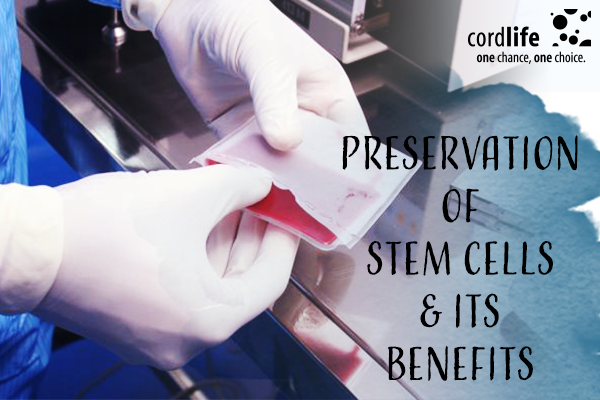Table of Contents
- Let Us Explore the Benefits Of Preserving Stem Cells
- 1. It Can Save Life
- 2. Cord Blood Stem Cells Will Always Be a Perfect Match for Your Baby
- 3. Cord Blood Stem Cells Have Potential Sibling/Family Use
- 4. Stem Cell Research is Revealing Exciting Future Uses
- 5. Umbilical Cord Stem Cells Have Greater Therapeutic Potential
- 6. You Can Store Your Baby’s Stem Cells For 20 Years or More
- 7. You Have An Option of Storing Your Baby’s Stem Cells Locally or Internationally
Embryonic stem cells are pluripotent stem cells which can give rise to various types of cells that builds up a human body. The embryonic cells are formed from the inner cell mass of the blastocyst and the blastocyst is the early stage of the embryo before the implantation. Adult stem cells have demonstrated an effective human therapeutic potential. Currently, human embryonic stem cells are used principally for understanding growth and disease development but also hold enormous medicinal potential.
The capability to preserve stem cells is difficult for their use in medical applications. The benefits of stem cell preservation allow the movement of cells between sites, as well as completion of safety and quality testing. Preservation allows the development of a ‘manufacturing paradigm’ for cell therapies, thereby maximizing the number of products that can be produced at a given facility
Let Us Explore the Benefits Of Preserving Stem Cells
1. It Can Save Life
Umbilical cord blood is an extremely rich source of stem cells that are used to treat more than 80 life threatening diseases and disorders – including cancer, blood disorders, immune system disorders, and genetic diseases. Stem cells can also rebuild the immune system after chemotherapy and be used as an alternative to a bone marrow transplant.
2. Cord Blood Stem Cells Will Always Be a Perfect Match for Your Baby
There are no ifs or buts about this.
Stem cells can help to repair or rebuild injured or damaged cells for your child and potentially other family members too.
3. Cord Blood Stem Cells Have Potential Sibling/Family Use
There’s a 1:4 (25%) chance of being a perfect match for a sibling. With cord blood transplants, it is however not always necessary to have a perfect match and, depending, for example, on the number of stem cells in the collection, a lesser match may be acceptable.
4. Stem Cell Research is Revealing Exciting Future Uses
Science is progressing every day. There are already a number of clinical trials which are being undertaken with umbilical cord blood and cord tissue stem cells – these include clinical trials for blood disorders, as well as for neurological conditions such as cerebral palsy, autism, stroke, anoxic and traumatic brain injury, for diabetes and, for example, for muscle repair and arthritis.
5. Umbilical Cord Stem Cells Have Greater Therapeutic Potential
Umbilical cord stem cells are young and active in comparison with stem cells from other sources like the bone marrow which mean that they can differentiate faster. Think of it as the master template!
The umbilical cord blood stem cells are also more ‘immunologically naïve’ than bone marrow stem cells as they have not been exposed to outside immune stimulation (such as infections). In allogeneic transplants (such as between siblings) they are less likely to cause the transplant-related complication of graft-versus-host disease.
Another important reason to store at birth is that your baby’s stem cells will be collected and ready to use immediately if necessary. There is no need to take the time to locate a possible donor for bone marrow and then determine whether he or she is still willing and able to donate if required for a sibling transplant.
A 1 in a 100 000 chance isn’t enough – depending on a person’s tissue type, the chance of finding a bone marrow donor may be less than 1 in a 100 000.
6. You Can Store Your Baby’s Stem Cells For 20 Years or More
Stem cells are stored in special cryo-preservation bags which are overwrapped and placed, individually, in aluminium protective cases. Each sample is labelled with a unique identifying code and stored, in a cryo-preservation tank, in the vapour phase of liquid nitrogen (at approximately minus 196°c). Evidence shows that after 23 years of preservation at these world-class standards, stem cells are still healthy and good to use. Therefore, it is conceivable that these cells will be stored for many years in the future – making it a lasting gift to your children that could even be passed on to grandkids.
7. You Have An Option of Storing Your Baby’s Stem Cells Locally or Internationally
If you are moving countries, you can chat to stem cell banks about moving the storage somewhere close to you. It can be shipped in their frozen state anywhere in the world. You would, however, be liable for the cost of the relocation.
The use of stem cells to treat injury or disorders by introducing healthy cells to damaged tissues has been considered a medical breakthrough and nowadays it has become the best possible treatment for a wide range of diseases. These include the treatment of some deadly diseases whose cure is not being discovered yet. So, before getting too late let us save the umbilical cord and preserve it for further use.
